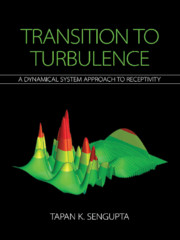Book contents
- Frontmatter
- Dedication
- Contents
- Preface
- 1 Receptivity, Instability, and Transition: A Perspective
- 2 Dynamical System Theory and Role of Equilibrium Flows
- 3 Fundamentals of Scientific Computing
- 4 Instability and Transition
- 5 Receptivity Analysis: Relation with Instability Experiments
- 6 Dynamical System Theory of Linear Receptivity
- 7 Nonlinear, Nonparallel Effects on Receptivity, Instability, and Transition
- 8 Three-Dimensional Routes of Transition to Turbulence
- 9 Receptivity to Free Stream Excitation: Theory, Computations, and Experiments
- 10 Nonlinear Receptivity Theories: Hopf Bifurcations and Proper Orthogonal Decomposition for Instability Studies
- 11 Mixed Convection Flow
- 12 Baroclinic Instability: Rayleigh–Taylor Instability
- 13 Coherent Structure Tracking in Transitional and Turbulent Flows
- 14 The Route of Transition to Turbulence: Solution of Global Nonlinear Navier–Stokes Equation
- References
2 - Dynamical System Theory and Role of Equilibrium Flows
Published online by Cambridge University Press: 16 February 2021
- Frontmatter
- Dedication
- Contents
- Preface
- 1 Receptivity, Instability, and Transition: A Perspective
- 2 Dynamical System Theory and Role of Equilibrium Flows
- 3 Fundamentals of Scientific Computing
- 4 Instability and Transition
- 5 Receptivity Analysis: Relation with Instability Experiments
- 6 Dynamical System Theory of Linear Receptivity
- 7 Nonlinear, Nonparallel Effects on Receptivity, Instability, and Transition
- 8 Three-Dimensional Routes of Transition to Turbulence
- 9 Receptivity to Free Stream Excitation: Theory, Computations, and Experiments
- 10 Nonlinear Receptivity Theories: Hopf Bifurcations and Proper Orthogonal Decomposition for Instability Studies
- 11 Mixed Convection Flow
- 12 Baroclinic Instability: Rayleigh–Taylor Instability
- 13 Coherent Structure Tracking in Transitional and Turbulent Flows
- 14 The Route of Transition to Turbulence: Solution of Global Nonlinear Navier–Stokes Equation
- References
Summary
In Chapter 1, we have stated that in this book, the study of flow instability will be performed using dynamical system theory. For flow instability, we will follow the schematic shown in Figure 2.1 for flows undergoing transition to turbulence from a laminar state. The idea behind this path dates back to the famous pipe flow experiment of Osborne Reynolds, who understood that the phenomenon of transition depends upon the prevalent background disturbances. For this reason, Reynolds designed the experimental setup with utmost care to minimize sources of disturbances. The time of performing experiments were also so chosen that the disturbances were further minimized. Thus, the transition phenomenon significantly depends on the input to the system, referred to as the receptivity of the system.
The concept of receptivity is reflected in Figure 2.1, where the dynamical system is identified by the box with thick borders and input to this system is marked on the top. There are alternative processes which are marked inside the box indicating various mechanisms responsible for transition. The output of the system is the turbulent flow, shown at the bottom of the schematic. It has been noted in [405] that for experimentally generating Tollmien–Schlichting waves, a vibrating ribbon excited time-harmonically at a single frequency was successful, while acoustic excitation of a free stream was not effective. Readers should note that the eigenvalue analysis (as we will describe in Chapter 4) is not only incapable of distinguishing between wall and free stream excitation, but also incapable of distinguishing between vortical and acoustic excitations. This prompted researchers to initiate studies about the propensity of equilibrium flows to be more receptive to one type of input excitation over the other. This is the essence of ‘receptivity’, a term coined by Morkovin [298], whose study not only discusses amplitude of input excitation, but also quality, that is, different types of physical input excitations.
The initial state of the dynamical system is represented by an equilibrium flow. In this chapter, we will look at a few representative equilibrium flows with the help of which certain transition mechanisms will be explained in the book. The equilibrium flows are obtained from different levels of hierarchy of conservation equations for fluid flows. Readers are encouraged to peruse the books [412] and [551] for a range of equilibrium states for internal and external flows.
- Type
- Chapter
- Information
- Transition to TurbulenceA Dynamical System Approach to Receptivity, pp. 30 - 61Publisher: Cambridge University PressPrint publication year: 2021



